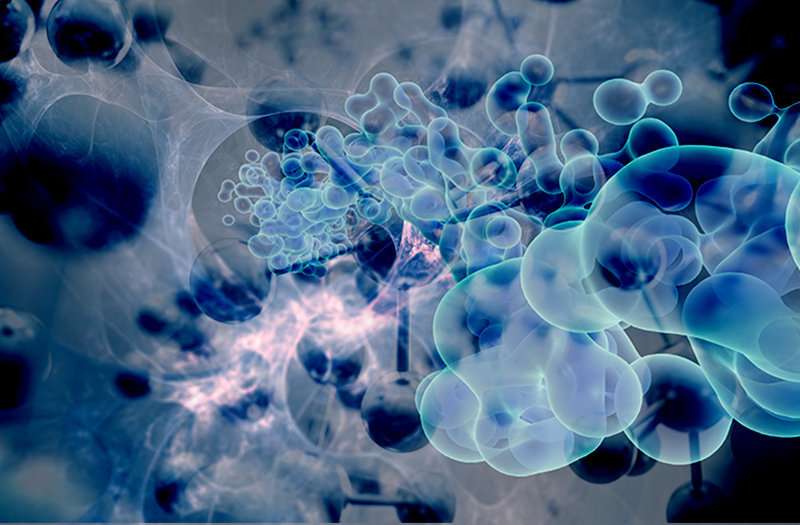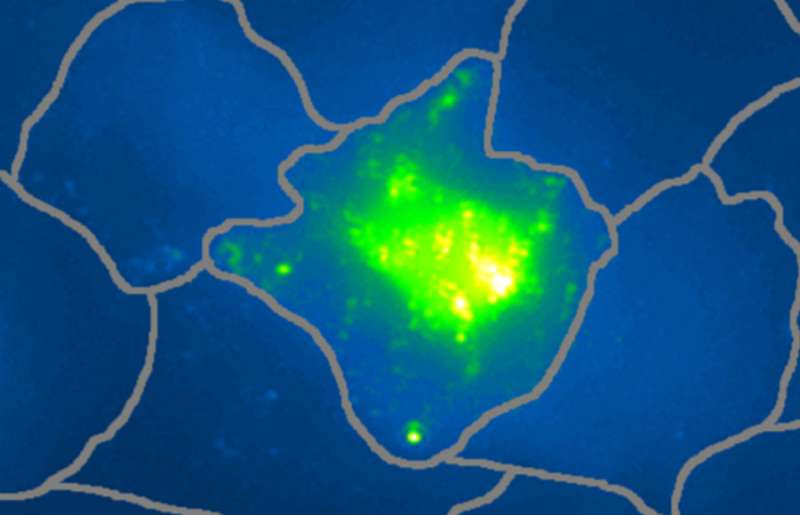Scientist develops hybrid nano-probe that can detect live cancer cells

Fabien Pinaud's big vision for treating cancer homes in on the smallest of targets.
Along with a team of scientists, he created a new hybrid nano-probe that could lead to noninvasive detection and treatment of the disease at the level of a single cell.
Pinaud, assistant professor of biological sciences, chemistry and physics and astronomy at USC Dornsife, developed a method for amplifying a biochemical signal on the surface of cancer cells.
The new technique binds and assembles gold nanoparticles in living cells using two fragments of a fluorescent protein as "molecular glue." These tiny probes act as amplifiers, enhancing researchers' ability to detect distinct biomarkers—things like overexpressed or mutated proteins—found in cancer cells.
The boosted signal allows the scientists to distinguish cancer cells from healthy cells through the use of Raman spectroscopy—a specialized laser imaging technique.
"Our approach takes advantage of the fact that we have two different nanoparticles which, on their own, are not active, but which become active when they assemble on cancer cells," said Pinaud, principle investigator of the Single Molecule Biophotonics Group and co-author of a related study, published Feb. 9 in Nature Communications.
Right on target
Using "molecular glue" assemblies to design novel nano-probes is common practice in biomedical research today, but most scientists build these with DNA rather than protein. While promising optical probes are being generated using DNA assemblies in test tubes, DNA is not a practical adhesive in live cells. Proteins are often better.

Pinaud and his team start with a fluorescent protein, one that glows when ultraviolet-blue light shines on it. The fluorescent protein is split into two fragments and each piece is attached to a set of gold nanoparticles. Both sets of nanoparticles zero-in on cells and bind specifically to biomarkers at the cell surface. As the nanoparticles collide on a cancer cell, the protein fragments naturally reassemble into the whole fluorescent protein.
The restructuring process provides two advantages. First, the activation of a new biochemical signal in the fluorescent protein is massively amplified by the nanoparticles, which allows for detection by Raman imaging.
Second, heat and ultrasounds are produced when the laser hits the nanoparticles, and that can be measured with ultrasound detectors. This dual effect provides high confidence that a detected cell is actually cancerous and not a false-positive signal from a healthy cell.
Scientists will next explore the possibility of destroying individual cancer cells, while leaving healthy cells unharmed, by using the laser to heat up the nanoparticles. "Going from imaging to killing cells is just about turning the knob on the laser that you use," Pinaud said.
Curiosity feeds convergence
Pinaud conducted the research with his former graduate student and co-author, Tuğba Köker, Ph.D. Having trained as a biologist in Turkey, Köker read a paper published by Pinaud in 2011 that laid the groundwork for this fluorescent protein research. She emailed him about the possibility of working together on the project as part of her graduate studies.
"I was on the plane the next week," Köker said.
She recalls the day when she received the first lab images showing their experiment's success. "I couldn't believe it. It was the breakthrough moment."
While Pinaud was excited, she said he was also skeptical. "That's how Fabien is. He always wants more certainty."
Journal information: Nature Communications
Provided by University of Southern California


















